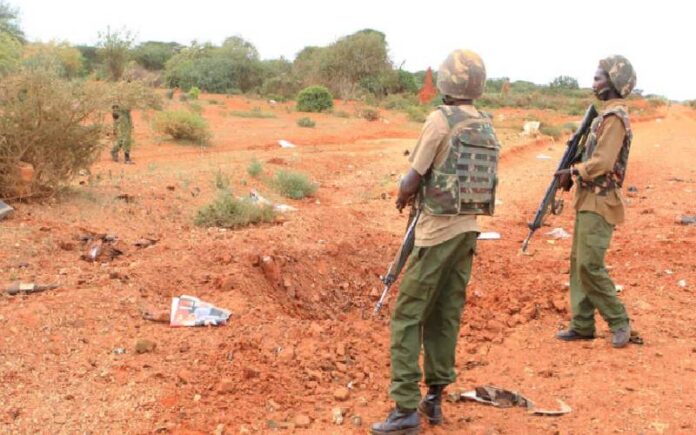NAIROBI – In less than a month, the Al Shabaab group has carried out at least six attacks in Garissa, Wajir and Mandera counties.
The attacks have killed at least 11 security officers and injured seven others; at least five civilians have also been wounded.
During the attacks, the extremists kill, maim and destroy property in the name of religion and in alleged retaliation for the presence of the Kenyan military in Somalia.
On Tuesday alone, eight security officers were killed after their vehicle was hit by a landmine in Bodhei, Garissa County.
The victims were patrolling the area when the explosive, planted on the road by suspected Al Shabaab militants, blew up their vehicle.
Earlier in the day, a bus travelling from Nairobi to Mandera was shot at by gunmen suspected to be Al Shabaab members.
The incident, which took place at Tarbaj in Wajir County, left three passengers with gunshot wounds.
Terror activities stepped up
The Al Qaeda-affiliated militia group seems to have stepped up its terror activities in the Northeastern region that neighbours Somalia, days after they attacked an African Union Transition Mission in Somalia (Atmis) base in Buulo Mareer in Shabelle on May 26.
The militia, estimated to be in their hundreds, stormed a Uganda People’s Defence Force camp with vehicle-borne explosive devices and suicide bombers and massacred more than 50 soldiers and kidnapped others.
On June 7, a land rover ferrying police officers from Alungu to Elwak was hit by an Improvised Explosive Device (IED) that had been planted on the route. Seven officers were injured in the incident.
On June 2, two police officers who were conducting patrols on the Elele-Takaba road a few kilometres from Alungu were killed and five others injured after they were hit by a rocket-propelled grenade fired by the militants.
Mandera County Commissioner Amos Mariba attributed the rising raids to the high presence of militants in the county due to an ongoing crackdown in Somalia.
“Most of the AS members have crossed into Mandera as they run away from the ongoing crackdown in Somalia. We have activated our security response plan and we are tracking them down,” Mr Mariba warned.
But Wajir Governor Ahmed Abdullahi attributed the increase in terror activities to improved vegetation and availability of water after the recent rainfall.
In Somalia, apart from the increased bombardment of militant hideouts by the US and other forces, civilians have joined a hunt for the extremists making their stay unbearable.
Many of the militants are now seeking refuge in Kenya.
Ms Halima Siad, a resident of Wajir blamed the government’s plan to re-open the border for the increased attacks in the region.
“We have cartels engaging in goods smuggling from Kismayo to Eastleigh in Nairobi and with an open border, their illegal activities will be affected,” she said.
She claimed that the cartels could be using the militants to instil fear in government agencies since they are not ready to pay taxes.
But as business cartels are fingered in the current rise in terror activities, the national government has announced a Ksh20 billion ($143.43 million) budget in enhancing security in the region.
Interior Cabinet Secretary Kithure Kindiki announced the budget while in Garissa on June 2.
“We have had security challenges caused by Al Shabaab from our neighbouring country. This terrorist group has caused a lot of damage to the extent that we have lost security officers and government officials. We are ready to deal with the situation,” the CS said then.
Operating bases
In readiness to respond to the terror threats, Kenya has constructed 14 fully equipped forward operating bases along the border with Somalia as part of efforts to bolster security ahead of next year’s drawdown of its forces from Somalia.
The bases will play a critical role in the phased reopening of the border.
Kenya agreed to officially reopen its border points with Somalia in Mandera, Lamu and Garissa by the end of August.
The country has remained on a high alert since the Somalia government kicked off a massive crackdown on the Al Shabaab group in August last year.
The crackdown, according to security experts, has forced the militants to run into Kenya and find a hiding haven.
While in Wajir, Northeastern Regional Commissioner John Otieno revealed that the militants are in at least four sub-counties in Wajir alone.
According to Mr Otieno, security agencies are relying on local communities in tracking the movement of the terrorists from Somalia to Kenya.
“Patriotic elders have undertaken to work with us to defeat terrorism. We understand that they have invaluable tip-offs and crucial information on how we can beat the enemy,” Mr Otieno said after a meeting with clan elders and religious leaders in Wajir.
As the regional security committee boss exuded confidence in working with the locals in winning against the terror group, Mr Hassan Gure, a resident of Mandera warned the government against trusting everyone.
“Majority of the Al Shabaab militants are locals who understand our environment very well, some of them are our own sons. We have locals who are sympathisers of this terror group. How does the government know that it’s dealing with a genuine person?” Mr Gure posed.
Locals accused
Several security agencies have accused some locals in Mandera, Wajir and Garissa of collaborating with the militants.
This dalliance has led to deaths, destruction of property and untold injuries among many victims of the terrorist acts in the Northeastern Region.
Members of the community, fearing reprisals from terror groups after sharing information with security agencies always choose to remain silent on any terror-related matter.
The militants while in transit, interact with herders and some villagers in these counties, warning them against making reports to the authorities.
And just as the government seeks intelligence information on terrorist activities from the locals, the militants seek the same from the locals against the security agencies.
The militants have in the past abducted locals including chiefs only to milk information from them.
“The Al Shabaab is always interested in the operation of the security agencies in an area and on how they can gain access to their target,” Mr Ali Shabaan said.
The sought information is usually about when security agencies pass through an area and their strength in firepower and numbers.
With this, the militants easily plan an ambush and plant explosives on the road regularly used by security agencies.
Some collaborators also provide shelter, food, transport and information to the militants.
A high level of poverty is also to blame for the increase in recruitment and radicalisation in the region.
Source: Daily Nation





